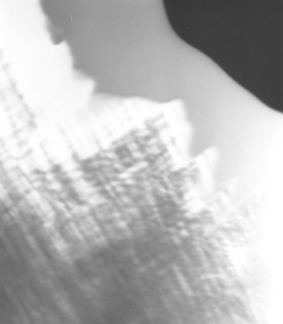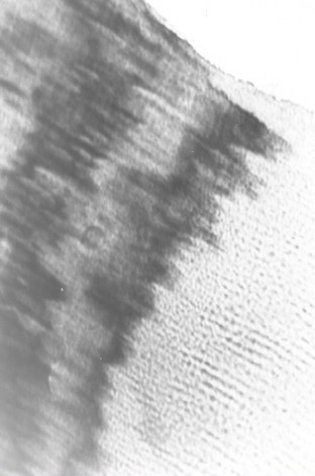by Prof. Mauro Prencipe - mauro.prencipe @ unito.it
Department of Mineralogical and Petrological Sciences - University of Turin
Member of the Board of Directors of CICAP - Piedmont Group and Scientific Director of the magazine "The Voice Skeptic"
Date: January 27, 2005 mauro.prencipe@unito.it
If you can play a mov file (can use Quicktime) you can download a video clip showing an electrospectrographic analysis of Sai vibuthi taken from a picture carried out by Dr. Jürgen Evers of Munich University.
Satya Sai Baba is probably the best known among the characters often referred to by the name of Guru or Santoni, his fame is due to a mixture of elements common to many of them, such as the alleged miraculous ability, the ability to materialize objects and a series of other phenomena more or less spectacular, much appreciated by their followers. In the case of Sai Baba , this mixture is particularly successful as seen by the following that the Guru was able to get around the World.
Among the many performances of the Holy Man, one of particular interest is the materialization of vibhuti , also known as the Sacred Ash, that Sai Baba produced in large quantities for its faithful. The vibhuti is in effect as a gray powder that resembles the ashes properties that are attributed to it would be simplistic to define as miraculous, especially for the health benefits that would result from its use.
It is perhaps of some unknown substance with characteristics unknown?
To answer this question, it 's definitely worth a look in-depth at the Sacred Ash , with the tools that science makes available to us: perhaps we could be faced with amazing properties!
From a preliminary observation by optical microscopy showed that the vibuthi is not a simple substance but is of the composite type , being constituted by a mixture of granules colorless ( transparent ) and white granules , accompanied by particles of dark color which , in ' together , give the color gray dust.
The morphology of the grains, the optical properties exhibited in polarized light and type of the numerous fractures observed , strongly suggest a crystalline nature of the material , which has guided the choice of the most refined methods of investigation , particularly suitable for analysis of crystalline materials ( that looks a bit ' in nature constitute the bulk of all solid matter exists) .
Now let's see the details of the individual analytical techniques employed : the X-ray diffraction , electron microscopy and microprobe chemical analysis.
X-ray diffractometry The high background in the low angle region of the spectrum ( 20-25 ° ) also shows the presence of a certain amount of amorphous material ( non-crystalline ) or , in any case , poorly crystallized.
|
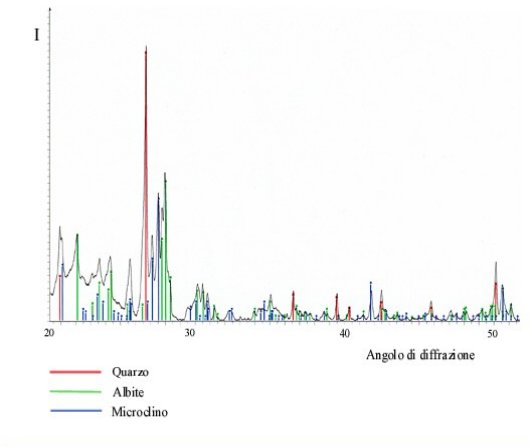 |
Electron Microscopy Some of the granules vibuthi were observed at the transmission electron microscope (Philips, model CM12, operated at 120 KV). The microscope has confirmed the presence of the mineral phases already observed X-ray, and has also allowed us to obtain new information about their origin and to identify the presence of other minerals minority, in a concentration too low for the observation of X-ray Microscopy investigations have been focused in particular on feldspars (plagioclase and microcline). The quartz not presented instead characteristics of particular interest, which may require further analysis beyond that diffraction. The left image shows the shape of electron diffraction of a granule of K-feldspar (microcline), oriented according to the axis of zone [102]: the cross shape of the spot of diffraction is produced by the particular type of characteristic of the gemination mineral crystallized in Nature, from a magma at high temperature and cooled very slowly (millions of years) within a body of intrusive rock. |
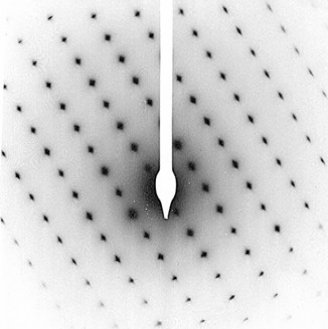 |
| The picture on the right is a positive print of a diffraction produced by K-feldspar, oriented along a different axis of the area. the cross shape of the diffracted spot is particularly noticeable here. The largest spot, in the center of the photo, is the image of the direct beam | 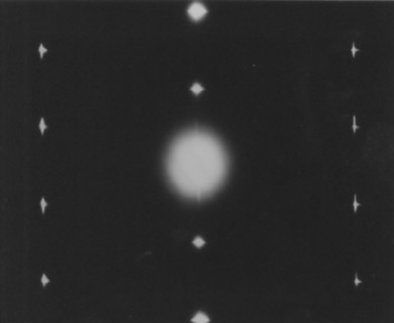 |
| The photo on the right is a picture in the dark field of K-feldspar and, specifically, the area that produced the diffraction of the previous photo. The photo shows an area of ??about 2 square millimeter of ten millionths (380000 magnification) are visible where two sets of slats, approximately orthogonal, which constitute individuals twins. | 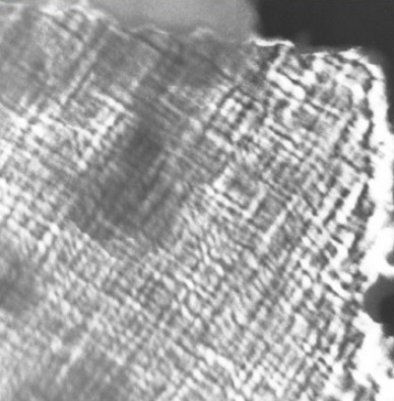 |
